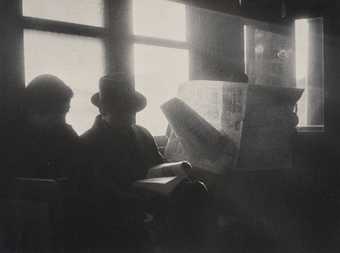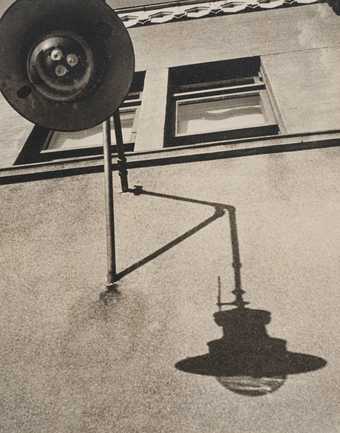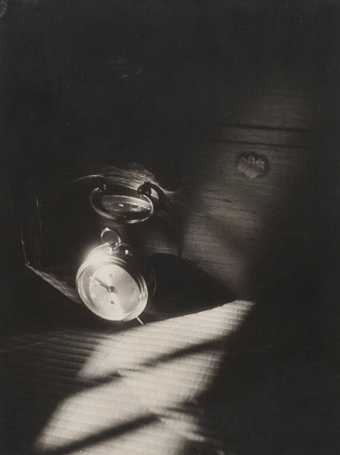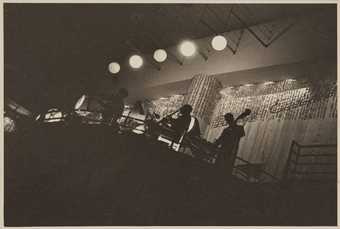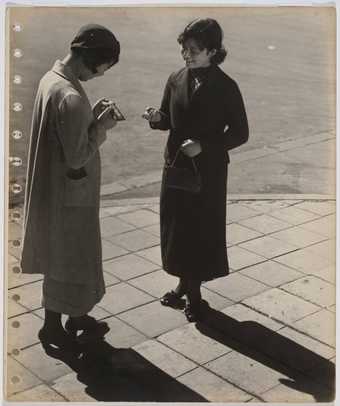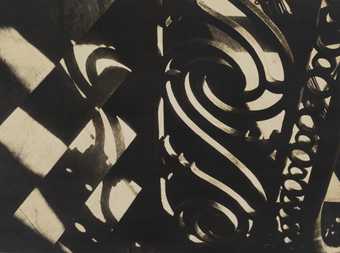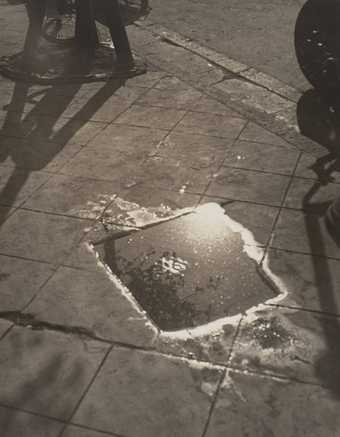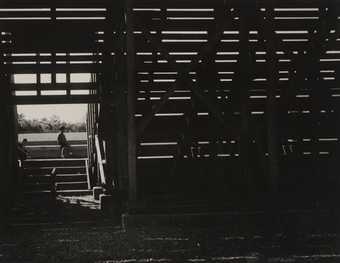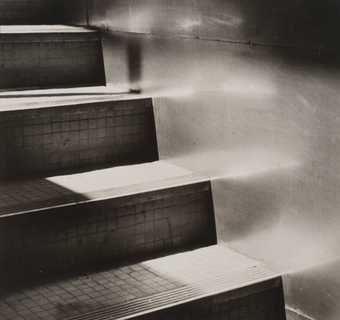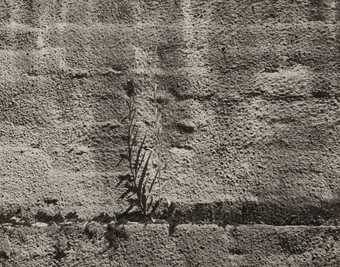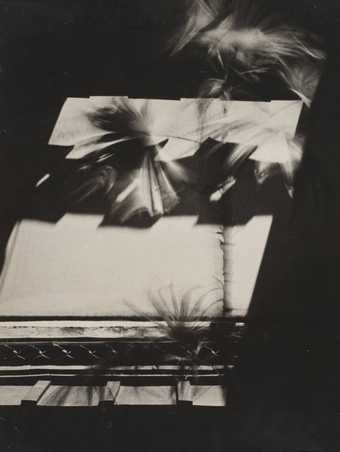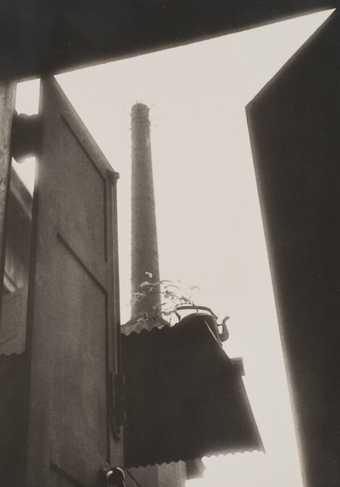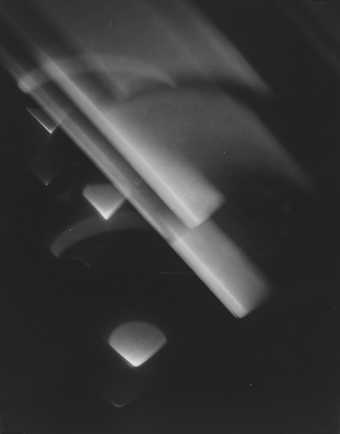
In Tate Modern
- Artist
- Shikanosuke Yagaki 1897–1966
- Medium
- Photograph, gelatin silver print on paper
- Dimensions
- Support: 238 × 222 mm
- Collection
- Tate
- Acquisition
- Presented by Jacqui Brantjes and Daniel Pittack 2010
- Reference
- P13147
Summary
Untitled (Street) is a black and white gelatin silver print on paper, set within a window mount and framed. The image shows the front part of a car seen from its right side. Sunlight is reflected in the windscreen and the metal bodywork, blanching the upper half of the image and creating a sense of movement. The strength of the reflection forms a glow that partially obscures the car. This sunlight diffuses as it moves outwards to create a circular dappling effect in the centre of the image. Behind the car, the roofs of other vehicles are visible. The foreground of the photograph is in shadow, so that the viewer’s attention is drawn to the activity beyond.
Untitled (Street) was taken between 1930 and 1939 by amateur Japanese photographer Shikanosuke Yagaki. Interest in photography surged in Japan in the wake of the Great Kanto earthquake of 1923. At this time, newspapers had become inexpensive and easy to circulate, and the documentary photographs of the disaster contained within the pages of the press increased the status of the photographic medium. As Tokyo was rebuilt, photographers continued to document the emergence of the modern city and the consequences of its refashioning in concrete, glass and steel. This modern Japanese photography movement became known as Shinko Shashin and magazines such as Japan Photographic Annual and Asahi Camera, launched in 1925 and 1926 respectively, provided a platform for the work of its members. Many photographic clubs also emerged at this time, linked by the All Japan Association of Photographic Societies, which enabled exhibitions of its members’ work. Yagaki was an active member of three of these groups throughout the 1930s: the Sanwa Bank Photo Club, the Karashishi-kai Photo Group and the Kyoto Leica Club.
A further consequence of the increased appetite for photography in Japan was that exhibitions of work by European modernist and surrealist photographers were imported and toured the country, including a 1929 Werkbund exhibition of German photographs called Film und Foto which featured the work of artists from the Bauhaus such as Laszlo Maholy-Nagy, Marianne Brandt and T. Lux Feininger. The influence of these European photographers can be observed in the images created by their Japanese counterparts, including those of Yagaki. His photographs, which are also represented in the Tate collection by works such as Untitled (Street lamp and shadow) 1930–9 (Tate P13148) and Untitled (Clock) 1930–9 (Tate P13149), employ an unusual vantage point and focus on uncovering the unexpected beauty that can be found in the everyday. Yagaki’s work also embodies the Japanese idea of ‘wabi-sabi’, a philosophy that embraces the transient and the imperfect to capture a fleeting beauty. The convergence of these two influences is revealed in Yagaki’s sensitivity to the play of light, which enabled him to expand the viewer’s perspective by capturing the momentary shadows and reflections of his urban surroundings.
Further reading
Ryuichi Kaneko, Rhapsody of Modern Tokyo, exhibition catalogue, Metropolitan Museum of Photography, Tokyo 1993.
Gennifer Weisenfeld, Visual Cultures of Japanese Imperialism, Durham, North Carolina 2001.
Gennifer Weisenfeld, Imaging Disaster: Tokyo and the Visual Culture of Japan’s Great Earthquake of 1923, Oakland 2012.
Phoebe Roberts
May 2016
Supported by Christie’s.
Does this text contain inaccurate information or language that you feel we should improve or change? We would like to hear from you.
Display caption
Influenced by European modernism, Yagaki was a self-trained Japanese photographer active in the amateur camera clubs of Osaka and Kyoto throughout the 1930s. Untitled (Street) shows the front part of a parked car with strong sunlight reflected by the windscreen. Behind the car, the roofs of other vehicles are visible, revealing a glimpse of modern life in the cities of early Shōwa era Japan. Yagaki’s pictures belonged to the Shinko Shashin (‘New Photography’) movement, seeking to distance photography from painting and to capture dynamism in the everyday.
Gallery label, January 2022
Does this text contain inaccurate information or language that you feel we should improve or change? We would like to hear from you.
Explore
- architecture(30,960)
-
- townscapes / man-made features(21,603)
-
- townscape(3,297)
- formal qualities(12,454)
-
- photographic(4,673)
- transport: land(2,189)
-
- car(502)
You might like
-
Shikanosuke Yagaki Untitled (Interior)
1930–9 -
Shikanosuke Yagaki Untitled (Street lamp and shadow)
1930–9 -
Shikanosuke Yagaki Untitled (Clock)
1930–9 -
Shikanosuke Yagaki Jazz
1930–9 -
Ryukichi Shibuya Untitled (Advertising photograph, two women on street)
c.1936 -
Shikanosuke Yagaki Banister Detail
1930–9 -
Shikanosuke Yagaki Untitled (Street)
1930–9 -
Shikanosuke Yagaki Untitled (Interior of wooden building)
1930–9 -
Shikanosuke Yagaki Stairs
1930–9 -
Shikanosuke Yagaki Untitled (Plant and wall)
1930–9 -
Shikanosuke Yagaki Still Life
1930–9 -
Shikanosuke Yagaki Untitled (Composition with light)
1930–9 -
Shikanosuke Yagaki Sudden Wind
1930–9 -
Shikanosuke Yagaki Untitled (Interior with shutters)
1930–9 -
Hanaya Kanbee Light B
1930, printed 1970s

